
DUMBOdqR1445sq: 2D R14_4^5 2Q/1Q correlation with DUMBO decoupling pulse program (TopSpin2.1)
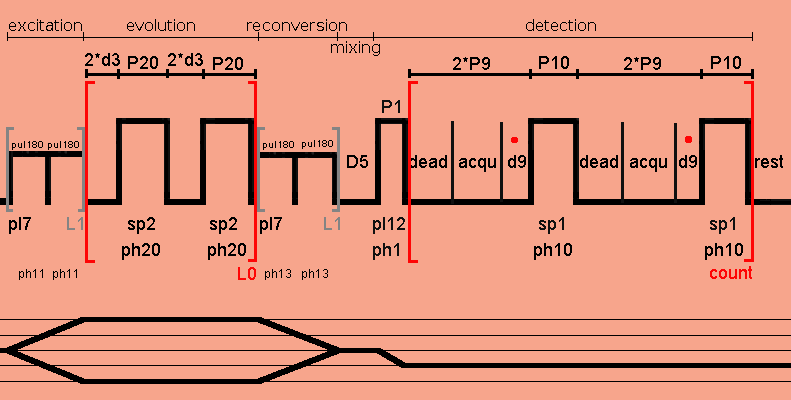
Since non-phase cycling is applied to the R1445 excitation pulse, four-phase cycling is applied to the detection pulse P1 for selecting the 0Q -> -1Q coherence order jump, and four-phase cycling is applied to the R1445 reconversion pulse for filtering DQ coherences.
;DUMBOdqR1445sq ;2D DQ-SQ proton-proton shift correlation ;with R14_4^5 DQ excitation/reconversion ;with homonuclear DUMBO decoupling DQ evolution without prepulses during t1 ;and windowed DUMBO acquisition ;S. P. Brown, A. Lesage, B. Elena and L. Emsley, J. Am. Chem. Soc. 126, 13230-13231 (2004). ;modified after Leskes, Madhu and Vega, Chem. Phys. Lett. to remove center artefact ;using STATES-TPPI ;This pulse program was written according to the corresponding DUMBO-sequence from ;the ENS-Lyon Pulse Program Library ;p9 2.4-4.5 usec, depending on probe deadtime, usually: ;for 200 and 300 MHz, CRAMPS probe required or use 4.5 usec, ;acqu or p9 must be as short as possible, avoiding dipolar coupling effects between DUMBO sequences, ;l11 or d9 must be as large as possible to improve S/N ratio, but keeping acqu positive and small, ;p1 : 90 degree 1H detection pulse ;p2 : presaturation 90 degree pulse ;p9 : acquisition window, 1.7-4.5 usec, depending on probe deadtime ;p10: dumbo-1 pulse for t2 ;p20: dumber-22 pulse for t1 ;d1 : recycle delay ;d5 : z filter delay, 0.1 μs or multiple of 1/cnst31, otherwise no signal ;d20: delay between saturation pulses ;l0 : 0 as initial t1 ;l1 : number R14_4^5 basic cycle elements, for protons 2-4 in real solids ;l3 : t1-increment multiplier, usually 2-4, to reduce required number of rows ;l11: number of oversampled data points to be averaged into one dwell point ;l20: # of pulses in saturation pulse train, 0 if undesired ;pl1 : 1H presaturation power ;pl7 : 1H power for R14_4^5 recoupling sequence, B1=(N/2n)*cnst31=1.75*cnst31 in Hz ;pl12: 1H power for pulses P1 ;pl13: dumbo power ;sp1 : 1H power for windowed dumbo-1 (t2) ;sp2 : 1H power for dumber-22 (t1) (usually somewhat less power than sp1 since ; there is no window); first set to pl13 as in setup experiments ;cnst3 : scaling factor for d3 ;cnst31: spinning frequency ;FnMode: undefined ;MC2 : STATES-TPPI ;NS : 16*n ;WDW : F1 QSINE 3, F2 QSINE 2 or EM ;zgoptns :-Dpresat or blank ;$COMMENT=homonuclear decoupling with w-DUMBO ;$CLASS=Solids ;$DIM=2D ;$TYPE=homonuclear decoupling ;$SUBTYPE=explicit acquisition ;$OWNER=hf ;cnst11 : to adjust t=0 for acquisition, if digmod = baseopt "acqt0=1u*cnst11" dwellmode auto #include <Avancesolids.incl> #include <Delayssolids.incl> "d3=cnst3*p9" ;p9 sets the window to make sure it is in microseconds "d9=0.1u*(l11)" ;set the sampling window, defined in Avancesolids.incl "blktr2 = 0.6u" ;this opens the transmitter gate 0.6 usec before the ;pulse, so the transmitter noise is not sampled "inf1=(l3*(2*d3+p20))*2" ;t1 increment "sp1=pl13" define delay dead "dead=1.2u" define delay acqu ;small window, defined by d3, 2.5-4.5 usec depending "acqu=2*p9-1.2u-d9-.1u" ;on probe deadtime ;acqu or p9 must be as short as possible, avoiding dipolar coupling effects ;l11 or d9 must be as large as possible but keeping acqu positive define delay cycle "cycle=4*p9+2*p10+.2u" define loopcounter count "count=aq/cycle" ;make sure td datapoints are sampled define delay rest ;make sure sampling proceeds throughout the sequence "rest=aq-(count*cycle)" define loopcounter count1 ;for STATES-TPPI procedure "count1=td1/2" ;and STATES cos/sin procedure define pulse pul180 "pul180=(2.0s/cnst31)/7" ;180° pulse "d31=1.0s/cnst31" 1 ze ;acquire into a cleared memory 2 d31 #ifdef presat ;set with -Dpresat pres, d20 ;delay between saturation pulses (p2 pl1 ph4):f1 ;saturation loop if required lo to pres times l20 #endif /* presat */ d1 ;recycle delay 10u reset1:f1 ;synchronise pulse and detection RF 1m rpp10 ;reset phase list pointer 1m rpp20 ;reset phase list pointer 1m rpp11 1m rpp13 10u pl7:f1 ;R14_4^5 DQ excitation: 3 pul180:f1 ph11 ipp11 ;increment phase ph11 pointer pul180:f1 ph11 ipp11 ;increment phase ph11 pointer lo to 3 times l1 5 d3 ;DQ evolution: d3 (p20:sp2 ph20^):f1 ;dumber22 d3 d3 (p20:sp2 ph20^):f1 ;dumber22 lo to 5 times l0 ;phase correction, due to t1 evolution period, ;is not applied to R14_4^5 DQ reconversion pulse. ;As a result, the 2D spectrum is shifted from F1=0. ;R14_4^5 DQ reconversion: 6 pul180:f1 ph13 ipp13 pl7:f1 ;increment phase ph13 pointer pul180:f1 ph13 ipp13 ;increment phase ph13 pointer lo to 6 times l1 d5 pl12:f1 ;z filter delay STARTADC ;prepare adc for sampling, set reference frequency, ;defined in Avancesolids.incl RESETPHASE ;reset reference phase (p1 ph1):f1 ;90° detection pulse at pl12 .1u DWL_CLK_ON 7 dead acqu d9 RG_ON .1u RG_OFF ;take l11 complex data points (p10:sp1 ph10^):f1 ;w-dumbo, use 24 usec at 600 MHz or higher dead acqu d9 RG_ON .1u RG_OFF (p10:sp1 ph10^):f1 lo to 7 times count ;make sure td points are sampled rest 1u DWL_CLK_OFF 1m ;DQ filtering (four phase cycling): 1m ip13*16384 ;increments all phases of ph13 by 90° rcyc=2 ;next scan 100m wr #0 if #0 zd ;save data 1m ip11*8192 ;increments all phases of ph11 by 45°, ;90° phase for DQ coherence lo to 2 times 2 ;t1 quadrature detection 8 1m iu0 ;increment counter l0 by 1 lo to 8 times l3 ;for multiple t1 increment ;1m rp11 ;reset all phases of ph11 and ph13 ;to their original values, i.e. to the values they ;1m rp13 ;had before the first ip11 and ip13 ;in case of STATES remove semicolon at beginning of the 2 lines lo to 2 times count1 ;count1 = td1/2 exit ;finished ph1= 1 1 1 1 2 2 2 2 3 3 3 3 0 0 0 0 ph10= 0 2 ;windowed dumbo phase during t2 ph11=(65536) 11704 53832 ; 64.29° 295.71° or 64.29° -64.29° ph13=(65536) 28088 4680 ;154.29° 25.71° or ph11 + 90° ;an overall constant phase shift of π/2 is applied ;to the reconversion pulse phases ph13 for time reversal ph4= 0 ;for presaturation pulse ph20=0 2 ;dumber22 phase during t1 ph30=0 ;needed for acquisition, involved in RESETPHASE ph31=0 2 0 2 1 3 1 3 2 0 2 0 3 1 3 1 ;involved in STARTADC ;ph31 = ph1 + 2*ph13 + 1
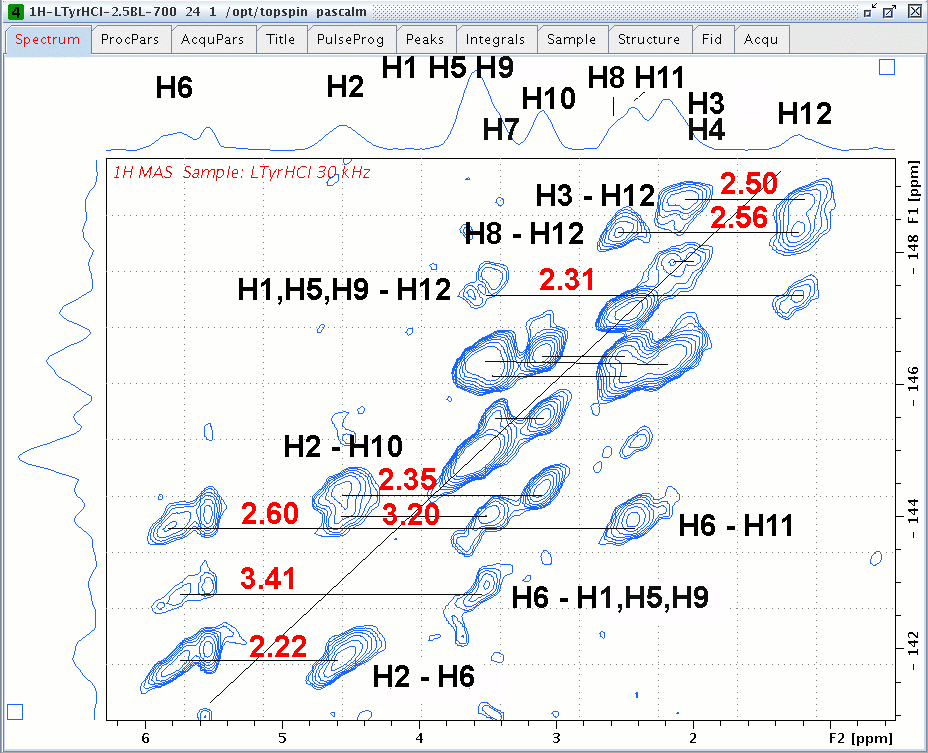
1H DQ/SQ spectrum of L-Tyrosine.HCl in a 2.5-mm diameter rotor spinning at 31.056 kHz and recorded with Bruker Avance III, 700 MHz SB US magnet; P9 = d3 = 1.80 µsec; 6*(2/cnst31)/7 = (2*d3 + P20)*2.
Pulseprogram parameters for DUMBOdqR1445sq.ppm:
| General | |
| PULPROG | DUMBOdqR1445sq.ppm |
| TD | 700 |
| NS | 64 |
| DS | 0 |
| SWH [Hz] | 20000.00 |
| AQ [s] | 0.0175500 |
| RG | 16 |
| DW [µs] | 25.000 |
| DE [µs] | 1.10 |
| CNST3 | 1.0000000 |
| CNST11 | 1.0000000 |
| CNST31 | 31056.0000000 |
| D1 [s] | 5.00000000 |
| d3 [s] | 0.00000180 |
| D5 [s] | 0.000000100 |
| d9 [s] | 0.00000200 |
| d31 [s] | 0.00003220 |
| inf1 [µs] | 55.20 |
| L0 | 0 |
| L1 | 4 |
| L3 | 1 |
| L11 | 20 |
| P9 [µs] | 1.80 |
| PL13 [dB] | -1.50 |
| ZGOPTNS | |
| acqu [s] | 0.00000030 |
| count | 316 |
| count1 | 128 |
| cycle [s] | 0.00005540 |
| de [µs] | 0.00 |
| dead [s] | 0.00000120 |
| rest [s] | 0.00004360 |
| Channel f1 | |
| NUC1 | 1H |
| P1 [µs] | 2.30 |
| P10 [µs] | 24.00 |
| P20 [µs] | 24.00 |
| PL1 [dB] | 2.00 |
| PL1W [W] | 55.62974930 |
| PL7 [dB] | 6.00 |
| PL7W [W] | 22.14660263 |
| PL12 [dB] | 2.00 |
| PL12W [W] | 55.62974930 |
| pul180 [µs] | 9.20 |
| SFO1 [MHz] | 700.1312952 |
| SP1 [dB] | -1.50 |
| SP2 [dB] | -1.50 |
| SPNAM1 | dumbo_1+0 |
| SPNAM2 | dumbo_1+0 |
| SPOAL1 | 0.500 |
| SPOAL2 | 0.500 |
| SPOFFS1 [Hz] | 0.00 |
| SPOFFS2 [Hz] | 0.00 |
Acquisition parameters:
| F2 | F1 | |
| Experiment | ||
| PULPROG | DUMBOdqR1445sq.ppm | |
| AQ_mod | DQD | |
| FnMODE | undefined | |
| TD | 700 | 256 |
| NS | 64 | |
| DS | 0 | |
| TD0 | 1 | |
| Width | ||
| SW [ppm] | 28.5661 | 25.8751 |
| SWH [Hz] | 20000.00 | 18115.941 |
| IN_F [µs] | 55.20 | |
| AQ [s] | 0.0175500 | 0.0070656 |
| Nucleus1 | ||
| NUC1 | 1H | 1H |
| O1 [Hz] | 1295.24 | 1295.24 |
| O1P [ppm] | 1.850 | 1.850 |
| SFO1 [MHz] | 700.1312952 | 700.1312952 |
| BF1 [MHz] | 700.1300000 | 700.1300000 |
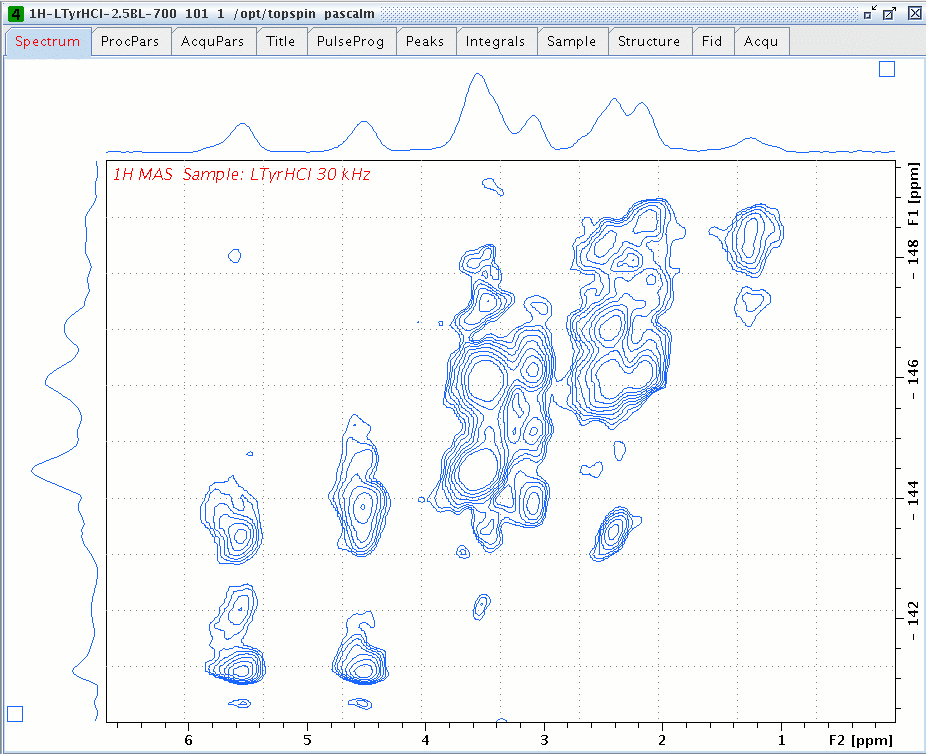
1H DQ/SQ spectrum of L-Tyrosine.HCl in a 2.5-mm diameter rotor spinning at 30 kHz and recorded with Bruker Avance III, 700 MHz SB US magnet; P9 = 1.80 µsec, d3 = 2.29 µsec; 6*(2/cnst31)/7 = (2*d3 + P20)*2.
Pulseprogram parameters for DUMBOdqR1445sq.ppm:
| General | |
| PULPROG | DUMBOdqR1445sq.ppm |
| TD | 700 |
| NS | 64 |
| DS | 0 |
| SWH [Hz] | 20000.00 |
| AQ [s] | 0.0175500 |
| RG | 4 |
| DW [µs] | 25.000 |
| DE [µs] | 1.10 |
| CNST3 | 1.2700000 |
| CNST11 | 1.0000000 |
| CNST31 | 30000.0000000 |
| D1 [s] | 5.00000000 |
| d3 [s] | 0.00000229 |
| D5 [s] | 0.000000100 |
| d9 [s] | 0.00000200 |
| d31 [s] | 0.00003333 |
| inf1 [µs] | 57.14 |
| L0 | 0 |
| L1 | 4 |
| L3 | 1 |
| L11 | 20 |
| P9 [µs] | 1.80 |
| PL13 [dB] | -1.50 |
| ZGOPTNS | |
| acqu [s] | 0.00000030 |
| count | 316 |
| count1 | 128 |
| cycle [s] | 0.00005540 |
| de [µs] | 0.00 |
| dead [s] | 0.00000120 |
| rest [s] | 0.00004360 |
| Channel f1 | |
| NUC1 | 1H |
| P1 [µs] | 2.30 |
| P10 [µs] | 24.00 |
| P20 [µs] | 24.00 |
| PL1 [dB] | 2.00 |
| PL1W [W] | 55.62974930 |
| PL7 [dB] | 6.00 |
| PL7W [W] | 22.14660263 |
| PL12 [dB] | 2.00 |
| PL12W [W] | 55.62974930 |
| pul180 [µs] | 9.52 |
| SFO1 [MHz] | 700.1312952 |
| SP1 [dB] | -1.50 |
| SP2 [dB] | 0.00 |
| SP2W [W] | 88.16721344 |
| SPNAM1 | dumbo_1+0 |
| SPNAM2 | dumbo_1+0 |
| SPOAL1 | 0.500 |
| SPOAL2 | 0.500 |
| SPOFFS1 [Hz] | 0.00 |
| SPOFFS2 [Hz] | 0.00 |
Acquisition parameters:
| F2 | F1 | |
| Experiment | ||
| PULPROG | DUMBOdqR1445sq.ppm | |
| AQ_mod | DQD | |
| FnMODE | undefined | |
| TD | 700 | 256 |
| NS | 64 | |
| DS | 0 | |
| TD0 | 1 | |
| Width | ||
| SW [ppm] | 28.5661 | 24.9966 |
| SWH [Hz] | 20000.00 | 17500.875 |
| IN_F [µs] | 57.14 | |
| AQ [s] | 0.0175500 | 0.0073139 |
| Nucleus1 | ||
| NUC1 | 1H | 1H |
| O1 [Hz] | 1295.24 | 1295.24 |
| O1P [ppm] | 1.850 | 1.850 |
| SFO1 [MHz] | 700.1312952 | 700.1312952 |
| BF1 [MHz] | 700.1300000 | 700.1300000 |

RN-DQ/SQ-DUMBO excitation pulse sequence.
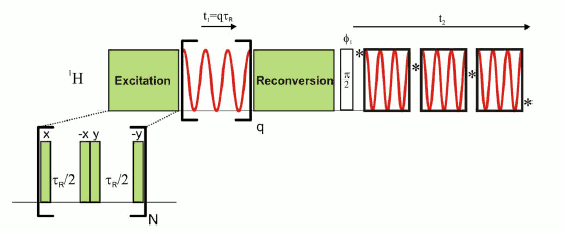
BABA-DQ/SQ-SAM excitation pulse sequence.
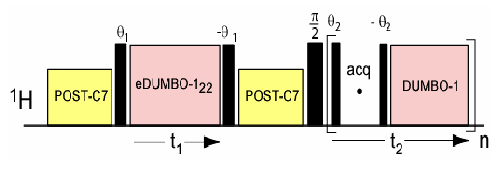
DQ-DUMBO excitation pulse sequence.